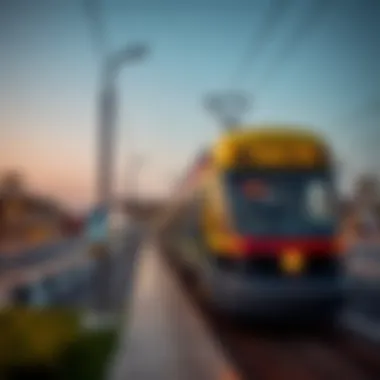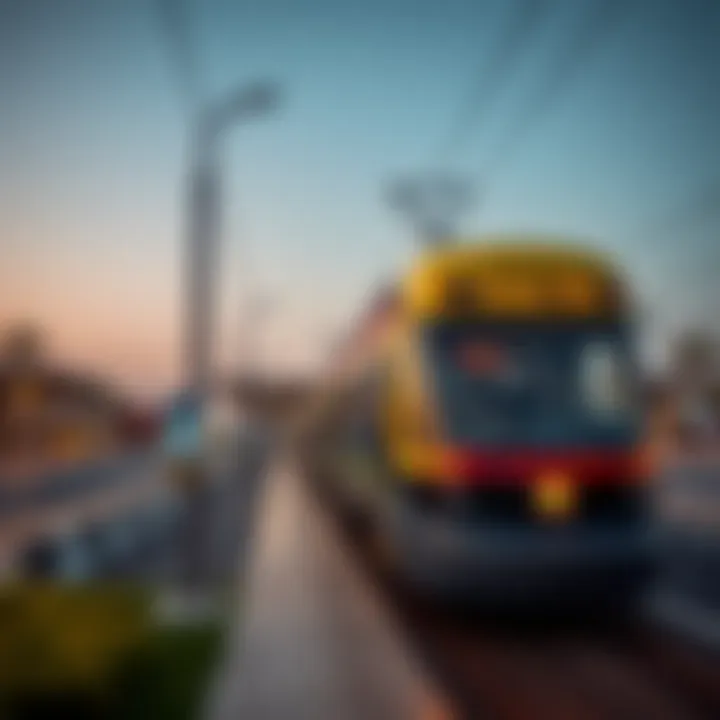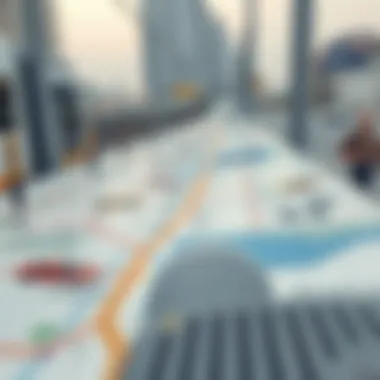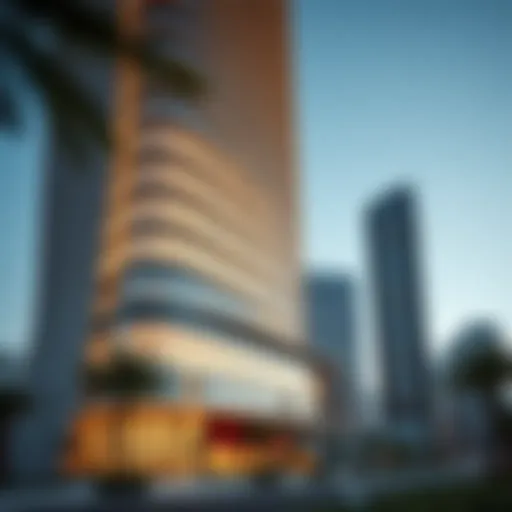Understanding Tram Dubai Timing: A Complete Overview


Intro
Understanding the tram system's operational timings in Dubai requires more than just a glance at a timetable. The tram network serves as a crucial artery in the city's transportation framework, particularly in areas like Dubai Marina and Jumeirah Beach Residence. It complements the metro and bus services, ensuring seamless connectivity for residents and visitors alike.
As you navigate through this guide, we delve into not only the daily schedules but also seasonal variances that can affect your travel plans. Commuters will find the insights here particularly beneficial for crunching the numbers on their daily rides. Additionally, we will touch upon how tram timings align with the broader transport network, offering a well-rounded understanding of how this modern transport option can cater to various commuting needs.
Market Trends
When discussing tram systems in major cities like Dubai, it's impossible to ignore the shifting landscape of urban transport. The tram network here is no exception, and it's crucial to keep an eye on the current trends.
- Current Operational Environment: The tram network is consistently seeing growth in ridership, directly influenced by Dubai's ambitious urban development and tourism strategies. The area's real estate market is riding this wave of development, with property prices reflecting the demand for proximity to public transport.
- Future Trends: Observers can predict that as shops, restaurants, and residential properties continue to sprout up along tram lines, the demand for tram services will only increase. Properties with easy access to tram stations may witness a considerable surge in value.
"The integration of the tram service is pivotal in enhancing property values in the surrounding areas. It's not just about convenience; it represents a lifestyle choice for potential buyers."
Embracing the Tram Experience
A trip to Dubai isn't complete without exploring the tram. It signifies more than just timely travel; it embodies the essence of Dubai's commitment to modernity and sustainability. Moreover, knowing how to navigate its schedules can significantly enhance one's experience here.
The trams generally operate from 6:30 AM to midnight on weekdays and have extended hours during weekends. However, special events and holidays may alter these timings, making it imperative for daily commuters to check the schedules ahead of time.
In addition, it's worth noting that there are specific times when trams may be more crowded. Commuters should be mindful of peak hours, which typically range from 7:30 AM to 9:30 AM and 5 PM to 7 PM.
In the coming sections, we will further delve into practical tips for optimal tram usage and how these timings can synergize with other transport modes in Dubai, positioning users for a smoother travel experience.
Overview of Dubai Tram System
Navigating through the bustling streets of Dubai has taken on a new dimension with the advent of the Dubai Tram System. Established to complement the existing transportation framework, the tram provides a vital link for commuters as they traverse this vibrant city. Trams offer a unique perspective on urban transit, merging ease of movement with effective accessibility.
The tram network serves not only to ease congestion but also to promote a more sustainable mode of transportation. Many residents and visitors find that using the tram removes the hassle of parking and simplifies travel. With stops strategically located near key areas, the system is designed to cater to various demographics, from tourists exploring the landmarks to residents commuting to work.
In essence, the tram enhances the integration of transport modes within Dubai, allowing for seamless transitions between the tram, metro, and buses. By recognizing its relevance in daily commutes, we can appreciate how this system contributes to the overall urban mobility landscape of the city.
Historical Context of Tram Services
The evolution of tram services in Dubai dates back to the ambitious vision of transforming the city into a global hub. Prior to the tram's launch in 2014, the absence of a dedicated rail service posed challenges in urban mobility. The decision to include trams was influenced by successful models seen in cities like Melbourne and San Francisco. These historical precedents provided substantial guidance in planning and design, allowing the Dubai Tram System to cater to contemporary needs while drawing on traditional concepts.
Since its inception, the tram has seen numerous enhancements, demonstrating Dubai's commitment to maintaining a cutting-edge transport network. From the construction of stations to the implementation of modern technologies, the tram's development is a testament to the city's dedication to innovation in transport.
Importance of Trams in Urban Mobility
Trams play a crucial role in enhancing urban mobility, effectively contributing to reducing carbon footprints and addressing traffic congestion. In a city as sprawling as Dubai, the tram acts as a lifeline for those seeking efficient travel options.
- Environmental Benefits: Trams emit less pollution compared to traditional vehicles, helping to contribute to a greener city. This is particularly pertinent in Dubai, where environmental considerations are increasingly prioritized.
- Ease of Access: Whether for residents needing a quick trip to the local mall or tourists visiting cultural sites, trams offer a convenience that mitigates the challenges of urban mobility.
- Integration with Other Systems: As mentioned earlier, the tram seamlessly integrates with other forms of public transport, facilitating fluid transitions for users. This integration mirrors the city's overall aim of creating a cohesive transport ecosystem.
The Dubai Tram System symbolizes forward-thinking urban development, providing an efficient transport alternative vital for the city's evolving landscape.
For further reading on the history of trams, you can explore resources like Wikipedia or Britannica.
Daily Operational Timings
Understanding the daily operational timings of Dubai's tram system is crucial for both residents and visitors. The tram network operates with a well-structured schedule, designed to efficiently cater to the commuting needs of a diverse population. Knowing the tram timings enables greater ease of travel, making it an integral part of urban mobility in Dubai. With a meticulous approach to scheduling, users can avoid long waits and ensure that their trips are smooth and convenient.


Weekday Schedule
During weekdays, the tram service in Dubai is especially important. Many people depend on it to get to work or school, and as a result, the timings tend to be more frequent. Generally, trams start running around 6:00 AM and continue until midnight. This schedule provides ample opportunity for morning commuters to catch a tram to start their day. Additionally, the frequency often increases during peak hours, accommodating the larger volume of passengers.
- Morning Peak (6:00 AM - 9:00 AM): Trams run every 7 to 10 minutes.
- Midday Hours (9:00 AM - 3:00 PM): Service frequency shifts to every 10 to 15 minutes.
- Evening Peak (4:00 PM - 7:00 PM): Similar to the morning peak, trams return to every 7 to 10 minutes.
- Late Night (After 9:00 PM): A reduced frequency of every 15 to 20 minutes.
For travelers, staying informed about the specific tram stops and associated timings can mean the difference between catching a ride or missing it. There are handy applications available for smartphones that display real-time tram schedules, making it easier to plan one’s journey.
Weekend Schedule
Weekends present a slightly different picture in terms of tram operations. The tram service usually starts around 9:00 AM and runs until 1:00 AM the following day, providing an excellent option for late-night outings. Since many families and individuals enjoy leisure activities during the weekends, the trams run at consistent intervals.
- Morning to Afternoon (9:00 AM - 3:00 PM): Trams are available every 10 to 15 minutes, which is adequate for those heading out for leisurely activities.
- Evening Hours (4:00 PM - 1:00 AM): Frequency remains stable at every 10 to 15 minutes, particularly useful for those attending events or dining out.
While the weekend schedule offers a more relaxed pace, it's still essential to be mindful of the last tram departures to avoid being stranded.
"Planning ahead with the tram schedule not only saves time but can transform your commuting experience from frustrating to seamless."
In summary, knowing when the trams run plays a pivotal role in making travel around Dubai simple and enjoyable. Whether it's getting to a workplace during weekdays or enjoying leisure time on weekends, understanding the tram's operational timings is key to navigating the city's transport landscape effectively.
Seasonal Variations in Tram Operations
Understanding how tram operations shift with the seasons is vital for passengers and stakeholders alike. Seasonal variations in tram timings can have notable impacts on daily travel plans, ridership levels, and overall operational efficiency. In a dynamic urban environment like Dubai, where temperatures can swing from scorching to pleasantly mild, adjustments to tram schedules are more than just logistical decisions; they are about maximizing service utility and user comfort.
Summer Operating Hours
During the sweltering months, typically from June to September, Dubai experiences extreme heat. To address the comfort and safety of its passengers, the tram system adjusts its operating hours significantly. This period sees a shift to earlier start times and later end times keeping in mind the high daytime temperatures.
- Start Time: The tram usually begins operations around 6:00 AM. This earlier schedule enables commuters to travel before the sun reaches its peak.
- End Time: Operations may extend until approximately midnight, allowing evening travelers to take advantage of the cooler air after sunset.
This scheduling not only ensures safety but also caters to the needs of tourists, who might want to explore the city in the evening or early morning.
"Adjusting tram timings during the summer isn’t just a matter of convenience; it’s a crucial health and safety measure to keep passengers comfortable."
Winter Operating Hours
Conversely, from October through May, Dubai enjoys more temperate weather, which necessitates a different approach. The winter months see a more regular tram schedule, reflecting increased ridership and a higher demand for service due to pleasant weather.
- Start Time: Trams typically commence at around 6:30 AM, aligning with standard working hours as well as the habits of early morning commuters.
- End Time: These trams continue to operate until around 1:00 AM, accommodating late-night events and activities, particularly during the bustling holiday season when tourists flock to the city.
Both summer and winter operating hours highlight how responsive the tram system is to local climate conditions. Each seasonal adjustment aims to improve user experience and safety, making the tram a reliable option for getting around.
Overall, being aware of these seasonal changes helps individuals plan their journeys more effectively, ensuring they make the most of this modern transit solution as they navigate the vibrant streets of Dubai.
Factors Influencing Tram Timings
Understanding the factors influencing tram timings is crucial for both residents and visitors in Dubai. As part of a rapidly growing urban landscape, the tram system plays a significant role in daily commutes and connectivity throughout the city. These factors directly affect the reliability, efficiency, and convenience of tram travel, which can in turn impact overall urban mobility.
Public Holidays and Special Events
Public holidays in Dubai, such as Eid Al Fitr and National Day, can significantly alter tram schedules. During these festive periods, demand for public transport generally escalates, with more residents and tourists relying on trams to attend celebrations, shopping festivals, and large gatherings. Consequently, the tram authorities often adjust their service hours to accommodate the increased passenger flow.


Special events, like the Dubai Shopping Festival or the annual marathon, also lead to tram schedule adjustments. Typically, operators may extend operating hours or increase the frequency of trams to ensure that the surge in commuters can be managed efficiently.
"Timing is everything, especially in bustling cities like Dubai. On special occasions, planning ahead can save you a lot of hassle."
Residents and visitors should be on the lookout for announcements regarding service changes during these key dates. It’s also wise to check official tram websites or apps for real-time updates, ensuring seamless travel experiences.
Traffic and Urban Infrastructure Developments
Tram timings can also be influenced by ongoing urban infrastructure developments and the overall traffic conditions in the city. With construction projects frequently taking place to enhance Dubai's urban framework, tram routes may experience temporary detours or delays. For instance, if a new road extension is underway near a tram stop, adjustments will be made to avoid congestion and ensure safety for commuters.
Moreover, traffic incidents, like accidents or roadworks, can cause ripple effects, leading to potential delays in tram services. Keeping an eye on local news and updates regarding traffic conditions can prepare passengers for unexpected changes.
Having reliable information about tram services during infrastructural changes can help not just commuters but also investors closely observing urban development trends, as these factors can indicate the growing area’s potential and livability. Regular commuters may want to adapt their schedules accordingly during construction seasons or periods of heavy traffic, ultimately leading to more satisfactory travel experiences.
As a result, understanding these factors becomes valuable in navigating the public transport landscape in Dubai. Remaining informed allows passengers to plan their journeys more effectively, thus reducing the likelihood of disruptions in their daily routines.
Integration with Other Transport Modes
Understanding how the tram system in Dubai integrates with other transport modes is crucial for maximizing its utility. A seamless connection between trams, metro systems, and buses can significantly enhance urban mobility for residents and visitors alike. When various transport options work in tandem, commuters can navigate the bustling city more efficiently.
Linkage with Metro Services
The tram network in Dubai is designed to complement the extensive metro system. Like pieces of a jigsaw puzzle, both modes of transport connect at key stations, allowing passengers to move from one to the other without much hassle. For instance, the tram stops at the Dubai Marina and Jumeirah Beach Residence stations provide easy access to the Red Line of the Metro. This interlinking is not just a convenience; it promotes the use of public transport instead of private vehicles, thus contributing to a greener environment.
Benefits of this linkage include:
- Reduced travel time: Transit passengers can switch between the tram and metro quickly, cutting down on their overall commute.
- Convenience: With easy connections, passengers can plan their journeys more effectively, knowing they can transfer on-the-go.
- Cost-effectiveness: Travelers often save money by using a combination of these services rather than relying solely on taxis or ride-sharing services.
As tram stops are located strategically in high-density areas, this link helps in managing rush hour traffic as well. The synchronization of tram and metro schedules further exacerbates the efficiency of travel, ensuring that one doesn't have to wait long for connections.
Buses and Other Public Transport
While trams and metros are pivotal in Dubai's public transport ecosystem, the role of buses amplifies this further. Commuters often rely on buses to access tram stations or cover areas that aren't directly served by the tram network.
- Widespread coverage: Buses in Dubai are extensive and cover regions not reachable by tram, ensuring connectivity throughout the city.
- Integration points: Key bus stops are often located near tram stations, facilitating easy transfers. Passengers can hop from the bus to the tram with minimal walking distance, reducing travel time and improving the user experience.
Moreover, the Roads and Transport Authority (RTA) supplements this public transport synergy with specialized services. For instance, the feeder buses that cater specifically to peak hours assist in managing high commuter loads, ensuring that the tram can operate efficiently without overcrowding.
By prioritizing interconnectivity in transport planning, Dubai sets a benchmark for other cities looking to enhance their urban transit systems.
For more information on public transport in Dubai, visit RTA Official Website or read about transport options on Wikipedia.
User Advice on Tram Travel
User advice plays a pivotal role in enhancing the experience of those utilizing the tram system in Dubai. Understanding how to navigate this transportation option efficiently can save time, reduce stress, and ultimately lead to a smoother travel experience. In a city as dynamic as Dubai, where modern convenience meets ancient traditions, being equipped with practical knowledge not only benefits individual passengers but also contributes to the overall efficiency of the tram network.
Planning Your Journey
When it comes to planning your tram journey, knowing your starting point and destination is just the tip of the iceberg. The tram system in Dubai operates on clearly defined routes, so familiarizing yourself with these is essential. Begin by checking the tram map, which you can find at stations or online on the Roads and Transport Authority (RTA) website. The tram stops have clear signs, making it straightforward to identify where you need to get on and off.
Another critical piece of advice is to consider peak travel times. Avoiding the rush hours significantly improves your chances of a comfortable journey. Typically, peak hours occur during weekday mornings from 7 AM to 9 AM and evenings from 5 PM to 8 PM. If your schedule allows it, aim for mid-morning or early afternoon journeys when trams are less crowded.


Additionally, ensure you have a Nol card ready, as it provides easier access to not just trams but also metro and bus services, helping streamline your overall travel experience. Top-ups can be done at multiple stations or online.Additionally, being aware of the tram frequency is crucial, especially if you're making connections. Trams generally run every 7 to 10 minutes during the day, offering ample opportunity to find one that suits your schedule.
Navigating Timetable Changes
Timetable changes can throw a wrench into any well-devised travel plans. However, staying updated can help you avoid any hiccups along the way. It’s a good idea to frequently check the official RTA website or the RTA mobile app, which provides real-time updates on tram schedules.
"Information is power. Stay informed about tram timings to keep the surprises at bay."
In addition to regular updates, public holidays and special events can lead to adjusted tram timings. For instance, around major holidays like Eid or the Dubai Shopping Festival, altered schedules might apply. Keeping an eye on announcements can save you from unexpected delays.
Lastly, downloading a navigation app that integrates public transport options can be a game-changer. Apps like Google Maps and RTA’s own application provide detailed information on tram arrivals, delays, and routing options in real time, ensuring you remain on the right track even with sudden timetable changes. These tools can significantly enhance your travel reliability in a bustling city like Dubai.
Future Developments in the Tram Network
As cities grow and evolve, so must their transportation systems. The future of the tram network in Dubai holds significant promise for enhancing urban mobility and contributing to the overall development of the city. Expansion, innovation, and seamless integration with existing systems are critical components that can reshape not just the tram experience but also the daily lives of residents and visitors alike. Addressing the expectations, aspirations, and challenges of these developments is essential for stakeholders including investors, homeowners, expatriates, agents, and developers.
Expansion Plans and New Routes
Dubai's strategic vision strongly emphasizes expanding its tram network to improve connectivity and accessibility across the region. This expansion isn't just about laying more tracks; it is about redefining how people navigate the urban landscape, making commuting more efficient and convenient. Future routes are being planned with the aim of reaching under-served areas and connecting key commercial and residential developments.
Potential new routes may include connections to popular destinations such as the Expo site or extending to major transport hubs like Dubai International Airport. Moreover, integrating tram services with other public transport options, like the Metro and bus services, can create a comprehensive network that minimizes travel times and enhances user satisfaction.
Some benefits of these expansion plans include:
- Enhanced accessibility: More areas will be reachable, facilitating better access to schools, businesses, and entertainment.
- Reduced congestion: With more trams running on expanded routes, reliance on personal vehicles may drop, easing traffic on roads.
- Sustainable development: Promoting public transport supports eco-friendly initiatives by reducing the carbon footprint associated with individual car use.
Technological Innovations in Tram Services
Technological advancements are another key aspect of the tram network's future. With an increasing push for smarter, safer, and faster services, Dubai's tram system is expected to implement state-of-the-art technology that enhances the commuter experience. From ticketing to real-time tracking, these innovations aim to smoothen and modernize the travel experience.
- Contactless payment systems enable a more streamlined approach to fare collection, reducing wait times at stations.
- GPS tracking installations will allow users to track trams in real-time via mobile applications, alleviating uncertainty around arrival times.
- Energy-efficient systems can also improve performance, such as introducing trams powered by renewable energy sources, which would significantly contribute to the city’s sustainability goals.
"The future of the tram system in Dubai is tied closely to technology, driving both efficiency and user satisfaction."
Through continuous innovation and expansion, the tram network in Dubai is set to become a key player in the city’s transport landscape, promising a smoother travel experience that aligns with both current demands and future growth. Investors and developers should keenly observe these developments as they unfold, recognizing their potential impact on urban planning and community growth.
End and Final Observations
Understanding the intricacies of the tram system in Dubai goes beyond just knowing the schedules. It paints a vivid picture of a modern city that stands on the brink of expansion and urban development. Recognizing tram timings is crucial for various stakeholders—be it investors eyeing commercial properties or homeowners planning their daily routines. The weave of public transport services, including trams, is a decisive element in the growth and allure of Dubai as a living and working destination.
Summarizing Key Insights
When sifting through the details included in this exhaustive guide, several pivotal insights emerge:
- Operational Timings Are Key: With both weekdays and weekends showcasing distinctive schedules, this aspect must not be overlooked by anyone commuting.
- Seasonal Adjustments Matter: The summer and winter operational hours suggest adaptability in services that cater to the local climate, impacting passenger flow.
- Events Shape Usage: Public holidays and special events substantially shift travel preferences. Understanding these patterns is essential for any planning initiatives.
- Integration Fluidity: The connection of the tram with metro services and other forms of public transport illustrates a well-thought-out urban mobility plan, enhancing accessibility across the city.
The Role of Trams in Sustainable Urban Growth
The tram network is more than just a transit option; it embodies a sustainable urban approach. By promoting public transport over personal vehicles, trams help reduce traffic congestion and pollution. This dual benefit cannot be overstated:
- Environmental Impact: With trams contributing to lower emisssions, Dubai heads towards meeting its sustainability goals, drawing in environmentally conscious investors.
- Urban Development: Areas served by tram lines often experience increased real estate interest, leading to vibrant communities that prioritize walkability and minimal car dependence.
- Cultural Integration: Trams connect people, reducing the social divide between expatriates and residents, and fostering a culture of shared urban experiences.
Altogether, these factors demonstrate the critical axis on which the future of urban mobility in Dubai balances. By flooring the pedal on sustainable growth through efficient public transport systems like trams, Dubai is not just building roads but also sculpting a vision that benefits everyone.
"Public transport is not just a method of travel; it’s a commitment to a cleaner and more connected city."
Stepping back, we see that the tram's role is integral in shaping a more sustainable and accessible urban landscape. With ongoing developments and the promise of new routes, the tram network remains a cornerstone of Dubai's ambitious future.



